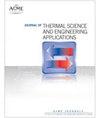具有蓄热功能的连续运行太阳能制冷吸收系统性能评价与优化设计分析
IF 1.4
4区 工程技术
Q3 ENGINEERING, MECHANICAL
引用次数: 0
摘要
摘要本文分析了一种由平板集热器、储热罐和吸收式制冷机组成的太阳能吸收式制冷系统。从各部件的能量平衡和制冷机的特性性能曲线出发,建立了无量纲模型。该模型用于确定水箱尺寸、太阳能集热器面积、制冷机尺寸、冷却负荷、冷却温度、热损失和质量流量等不同参数对性能的相互作用和影响。从分析来看,更小的太阳能集热器面积需要更低的冷却负荷和更小的储罐容积。1 × 10−5的特定冷却负荷将需要比考虑典型商业设计和操作参数的基线系统所需面积大2到6倍的特定太阳能集热器面积,具体取决于初始水箱温度。对于特定的储罐容积,也观察到类似的行为。对于基线系统,在初始储罐温度为1.19时,收集器的最小比面积为9.57。当冷却负荷为1 × 10−5时,最佳初始水箱温度为1.11,则太阳能集热器的最小比面积为25.26。4 × 10−4的特定水箱容积也将具有1.11的最佳初始水箱温度,使特定太阳能集热器面积最小化至28.18的值。本文的方法和分析可用于确定太阳能吸收式冷却系统的设计参数,使系统各尺寸之间的关系合理,以达到最佳运行。本文章由计算机程序翻译,如有差异,请以英文原文为准。
Performance evaluation and optimal design analysis of a continuous-operation solar-driven cooling absorption systems with thermal energy storage
Abstract A solar absorption cooling system consisting of a flat plate collector, thermal energy storage tank, and absorption chiller is analyzed in this work. A dimensionless model is developed from the energy balance on each component and the chiller’s characteristic performance curves. The model is used to determine the interaction and influence of different parameters such as tank size, solar collector area, chiller size, cooling load, cooling temperature, heat loss, and mass flow rates on the performance. From the analysis, smaller solar collector areas are required for lower cooling loads and smaller tank volumes. A specific cooling load of 1 × 10−5 will require a specific solar collector area between two and six times larger, depending on the initial tank temperature, than the area required for a baseline system that considers typical commercial design and operation parameters. A similar behavior was observed for the specific tank volume. For the baseline system, the minimum specific area of the collector of 9.57 is achieved for an initial tank temperature of 1.19. For a cooling load of 1 × 10−5, the optimum initial tank temperature will be 1.11 that results in a minimum specific solar collector area of 25.26. A specific tank volume of 4 × 10−4 will also have an optimum initial tank temperature of 1.11 that minimizes the specific solar collector area to a value of 28.18. The approach and analysis in this work can be used to determine design parameters for solar absorption cooling systems based on a proper relation among system’s dimensions to achieve optimum operation.
求助全文
通过发布文献求助,成功后即可免费获取论文全文。
去求助
来源期刊

Journal of Thermal Science and Engineering Applications
THERMODYNAMICSENGINEERING, MECHANICAL -ENGINEERING, MECHANICAL
CiteScore
3.60
自引率
9.50%
发文量
120
期刊介绍:
Applications in: Aerospace systems; Gas turbines; Biotechnology; Defense systems; Electronic and photonic equipment; Energy systems; Manufacturing; Refrigeration and air conditioning; Homeland security systems; Micro- and nanoscale devices; Petrochemical processing; Medical systems; Energy efficiency; Sustainability; Solar systems; Combustion systems
 求助内容:
求助内容: 应助结果提醒方式:
应助结果提醒方式:


